Crab and Asparagus Soup (Súp Măng Cua)
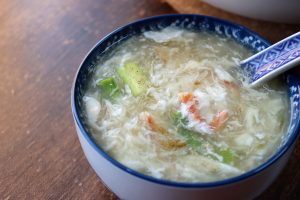
At a Vietnamese wedding dinner, one of the appetizers you’re likely to encounter is Crab and Asparagus Soup (Súp Măng Cua). This dish is prized for its elegant presentation and its delicate yet flavourful taste. Although not commonly found in many Vietnamese restaurants, it’s a delightful treat to prepare at home.
The key ingredients for this soup are crab meat and asparagus. In Vietnamese, asparagus is referred to as “măng tây” to distinguish it from “măng,” which denotes bamboo shoots. The soup is believed to have been introduced by the French, as asparagus does not thrive in Vietnam’s tropical climate.
What makes Crab and Asparagus Soup stand out from other traditional Vietnamese soups is its rich, thick consistency. It’s typically enjoyed on its own rather than with rice. This type of egg-drop soup is quite unique in Vietnamese cuisine and is one of the few soups served at banquets, weddings, and special occasions.

Here are a few notes on my Crab and Asparagus Soup recipe:
- I use green asparagus rather than white asparagus. Although white asparagus is ideal for maintaining the soup’s light colour, it can be harder to find and more expensive. Green asparagus works well and still results in a delicious soup. Fresh green asparagus requires more preparation time compared to canned green asparagus. Alternatively, you can use canned white asparagus if preferred.
- I use crab meat from pre-cooked crab legs and claws. While this option may be more expensive, it greatly enhances the soup’s flavour. If you don’t have enough of this fresh crab meat, you can also add canned crab meat.
- The traditional Crab and Asparagus Soup does not include quail eggs, but I find that adding them enhances the flavour profile. However, you can omit this ingredient if you prefer.
- I use my own prepared chicken stock for the broth. You can use homemade stock (preferably chicken for its light flavour) or canned chicken broth, adjusting the seasoning to taste.
- If you don’t have tapioca flour, you can use cornstarch as an alternative thickening agent for the soup.
- I highly recommend garnishing the soup with ground white pepper and a few drops of sesame oil before serving. These additions will enhance the flavour of the soup.
Q&As on Crab and Asparagus Soup

1. Is asparagus good for you?
Yes, asparagus is highly beneficial for your health. Here are some of the key benefits:
- Nutrient-Rich: Asparagus is packed with essential vitamins and minerals, including vitamins A, C, E, and K, as well as folate, iron, and potassium. These nutrients support various bodily functions, from immune health to blood clotting.
- Antioxidant Properties: Asparagus contains antioxidants like glutathione and flavonoids, which help combat oxidative stress and reduce inflammation in the body.
- Digestive Health: High in dietary fibre, asparagus promotes healthy digestion and can help prevent constipation.
- Low in Calories: Asparagus is low in calories and fat, making it a great addition to a balanced diet and helpful for weight management.
- Supports Heart Health: The fibre, potassium, and antioxidants in asparagus contribute to cardiovascular health by supporting healthy blood pressure levels and reducing the risk of heart disease.
- Natural Diuretic: Asparagus has diuretic properties, which can help reduce water retention and support kidney function.
Overall, incorporating asparagus into your diet can offer numerous health benefits while adding a tasty and versatile vegetable to your meals.
2. Is crab meat good for you?
Yes, crab meat is nutritious and offers several health benefits:
- High in Protein: Crab meat is a great source of high-quality protein, which is essential for muscle growth, repair, and overall body function.
- Rich in Vitamins and Minerals: Crab meat provides important nutrients, including vitamin B12, which supports nerve function and red blood cell production; selenium, an antioxidant that protects cells; and zinc, which is crucial for immune health.
- Low in Fat: Crab meat is relatively low in fat compared to other types of meat, making it a heart-healthy option.
- Omega-3 Fatty Acids: Crab meat contains omega-3 fatty acids, which are beneficial for heart health and may help reduce inflammation.
- Supports Healthy Metabolism: The B vitamins in crab meat help with energy production and metabolism.
- Hydrating: Crab meat has a high-water content, which can contribute to overall hydration.
However, it’s important to consume crab meat in moderation, as some types may contain higher levels of cholesterol and sodium. Additionally, individuals with shellfish allergies should avoid crab meat. Overall, when eaten as part of a balanced diet, crab meat can be a healthy and delicious addition to your meals.

3. What are the differences between white and green asparagus?
White and green asparagus differ in several key ways:
Growing Conditions:
- Green Asparagus: Grows above ground and is exposed to sunlight, which allows it to produce chlorophyll and develop its green colour.
- White Asparagus: Grows underground or is covered with soil or mulch to prevent exposure to sunlight, which keeps it from producing chlorophyll and results in its white colour.
Flavour:
- Green Asparagus: Has a more robust, slightly grassy flavour with a touch of sweetness.
- White Asparagus: Tends to have a milder, more delicate flavour and a slightly more tender texture.
Texture:
- Green Asparagus: Typically has a slightly firmer texture with a more pronounced crunch.
- White Asparagus: Usually has a softer and more tender texture, which can be more desirable in certain dishes.
Nutritional Content:
- Green Asparagus: Generally contains higher levels of vitamins A, C, and K, as well as more antioxidants due to the presence of chlorophyll.
- White Asparagus: While still nutritious, it may have slightly lower levels of these nutrients compared to green asparagus.
Cost and Availability:
- Green Asparagus: More commonly available and generally less expensive.
- White Asparagus: Less common and can be more expensive, often considered a delicacy in many regions.
Both types of asparagus offer unique flavours and textures and can be enjoyed in a variety of culinary applications.
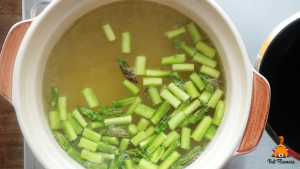
4. I’m deciding whether I should use fresh green asparagus or canned green asparagus for this soup. What are the differences between these?
Texture:
- Fresh Green Asparagus: Provides a crisp and firm texture, which adds a pleasant crunch to the soup. It maintains a good bite and structure when cooked.
- Canned Green Asparagus: Tends to be softer and more delicate due to the canning process, which can result in a mushier texture when added to the soup.
Flavour:
- Fresh Green Asparagus: Offers a vibrant, slightly grassy, and naturally sweet flavour that can enhance the overall taste of the soup.
- Canned Green Asparagus: May have a milder, less intense flavour. The preservation process can sometimes lead to a slightly tinny or altered taste.
Preparation:
- Fresh Green Asparagus: Requires washing, peeling, and cutting, which can be more time-consuming. You may also need to cook it for a bit longer to achieve the desired tenderness.
- Canned Green Asparagus: Comes pre-cooked and ready to use, making it more convenient and quicker to add to the soup. It requires minimal preparation.
Nutritional Value:
- Fresh Green Asparagus: Generally retains more of its nutrients, including vitamins and antioxidants, as it is less processed.
- Canned Green Asparagus: While still nutritious, some of the vitamins and minerals may be reduced during the canning process.
Cost and Availability:
- Fresh Green Asparagus: Often more expensive and may be less convenient to find depending on the season and location.
- Canned Green Asparagus: More affordable and readily available year-round.
Ultimately, the choice between fresh and canned green asparagus will depend on your preferences for texture, flavour, and convenience. Fresh asparagus can add a more robust flavour and texture to your soup, while canned asparagus offers ease of use and quick preparation.
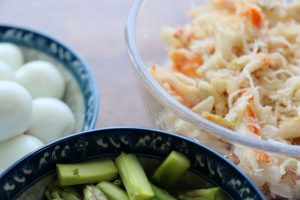
5. I’m deciding whether I should use fresh crab meat or canned crab meat for this soup. What are the pros and cons?
Here are the pros and cons of using fresh crab meat versus canned crab meat for your soup:
Fresh Crab Meat:
Pros:
- Flavour: Fresh crab meat has a richer, more vibrant flavour that can significantly enhance the taste of your soup.
- Texture: It offers a firmer, more succulent texture, which can be more satisfying in dishes where crab meat is a central ingredient.
- Nutritional Value: Generally, fresh crab meat retains more of its natural nutrients and vitamins compared to canned options.
Cons:
- Cost: Fresh crab meat is often more expensive than canned crab meat.
- Availability: It may be harder to find, depending on your location and the season.
- Preparation: Requires more preparation time, including cleaning and extracting meat from the crab legs and claws.
Canned Crab Meat:
Pros:
- Convenience: Canned crab meat is ready to use, saving time and effort in preparation. It is pre-cooked and easily incorporated into recipes.
- Cost: Generally. more affordable than fresh crab meat, making it a budget-friendly option.
- Availability: Readily available year-round, regardless of local crab fishing seasons.
Cons:
- Flavour: Canned crab meat may have a less intense flavour and can sometimes taste slightly tinny or processed.
- Texture: The texture can be softer and less firm than fresh crab meat, which might affect the overall mouthfeel of the soup.
- Nutritional Value: While still nutritious, some of the natural vitamins and minerals may be diminished during the canning process.
Ultimately, choosing between fresh and canned crab meat will depend on your priorities for flavour, texture, cost, and convenience. Fresh crab meat will offer a more premium taste and texture, while canned crab meat provides a more economical and convenient option.
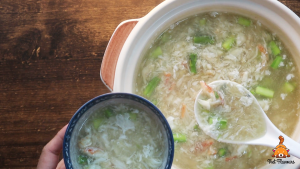
6. How long does it take to make this Crab and Asparagus Soup?
The total time required to make Crab and Asparagus Soup can vary depending on your choice of ingredients and preparation methods. Generally, the process includes both preparation and cooking time:
Preparation Time:
If using fresh crab meat, you will need to account for the time required to boil the crab (if not using pre-cooked crab) and extract the meat. This can take approximately 30-45 minutes, depending on the size of the crab and your skill level.
For fresh asparagus, you’ll need to clean, peel, and cut the asparagus, which can take around 10-15 minutes. Fresh asparagus also requires a longer cooking time compared to canned asparagus.
Cooking Time:
The cooking time for the soup itself is relatively quick. Once all ingredients are prepared, the soup typically takes about 20-25 minutes to cook, including simmering to develop flavour and allow the ingredients to blend.
Overall, the most time-consuming part of making this soup is the preparation, especially if you opt for fresh crab meat and asparagus. However, the effort is well worth it for the rich and delicious flavours of the soup.
7. How do you say “Crab and Asparagus Soup” in Vietnamese, and how do you pronounce it?
In Vietnamese, “Crab and Asparagus Soup” is called “Súp Măng Cua.”
- Súp (soup) is pronounced like “soop” with a soft “s.”
- Măng (asparagus) is pronounced like “mang” with a nasalized “a” sound, similar to “mung” in English.
- Cua (crab) is pronounced like “kwah,” with a short “u” sound.
So, the full pronunciation of “Súp Măng Cua” is approximately “soop mang kwah.”
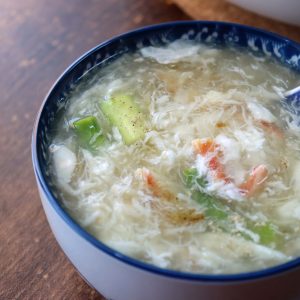
Recipe for Crab and Asparagus Soup (Súp Măng Cua)
Equipment
- 1 small pot
- 1 medium pot
- 1 nonstick skillet
Ingredients
- 5 cups prepared chicken stock
- 200 grams asparagus
- 170 grams crab meat (from 500 grams crab legs and claws)
- 2 egg whites
- 3 tablespoons tapioca flour
- Freshly ground shallots
- 10 quail eggs optional
- 95 grams canned crab meat optional
- For garnishes: Green onions and cilantro (finely chopped), ground white pepper, sesame oil
- For seasoning: Salt, mushroom powder
Instructions
- In a small pot, add the quail eggs, enough water to cover them, and a pinch of salt. Bring the water to a boil over medium-high heat. Once boiling, reduce the heat slightly and cook the eggs for about 5 minutes.
- Remove the eggs from the pot and place them in a bowl of cold water. Peel and set aside.
- Crack the 2 eggs and separate the whites from the yolks, discarding the yolks or reserving them for another use. Whisk them vigorously until they are slightly frothy and well combined. Set them aside for later use in the soup.
- Peel the tough outer layer from the asparagus stems, focusing especially on the lower parts where the skin is thicker. Once peeled, cut the asparagus into bite-sized pieces.
- In a small bowl, combine the tapioca flour with a small amount of cold water. Stir well until the mixture is smooth and free of lumps. Set the mixture aside until you are ready to add it to the soup.
- Remove the crab meat from the crab legs and claws, being careful to avoid including any small pieces of shell or cartilage. Tear the larger pieces of crab meat into smaller, bite-sized chunks, but avoid making them too small to retain their texture in the soup.
- If you find that you need more crab meat, you can add canned crab meat.
- Heat a small amount of oil in a nonstick skillet over medium-high heat. Add the finely chopped shallots to the hot oil and sauté, stirring frequently, until the shallots become translucent and aromatic.
- Add the prepared crab meat to the skillet with the shallots. Sauté for about 1 minute, allowing the flavours to meld. Season with a small amount of mushroom powder.
- Bring the prepared chicken stock to a boil over medium-high heat. Once boiling, season the stock lightly with salt and mushroom powder, adjusting the seasoning to taste. Allow the flavours to meld for a few minutes.
- Reduce the heat to a simmer and add the chopped asparagus to the pot. Cook the asparagus until it becomes tender. Once tender, gently stir in the sautéed crab meat, allowing it to heat through.
- Reduce the heat to medium and slowly pour in the whisked egg whites, stirring gently to form delicate ribbons in the broth. Continue to stir until the egg whites are fully incorporated and cooked through.
- Gradually stir in the tapioca flour mixture, ensuring it is evenly distributed throughout the soup. Stir gently to avoid clumps and to ensure the soup thickens smoothly.
- Lower the heat to medium-low and let the soup simmer for about 5 minutes, or until it reaches the desired thickness. If you are using quail eggs, add them to the soup at this stage and let them warm through.
- The Crab and Asparagus Soup is now ready to be served. Ladle the soup into bowls and garnish with finely chopped green onions, fresh cilantro, a sprinkle of ground white pepper, and a drizzle of sesame oil. Serve hot and enjoy!

